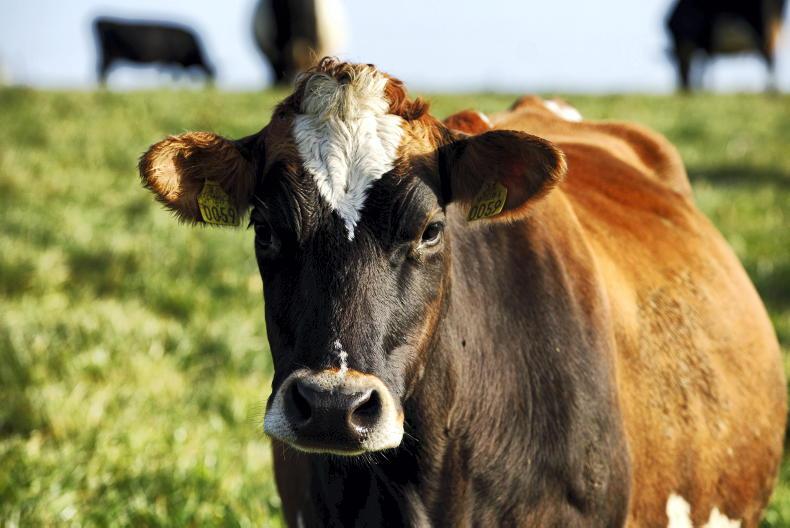Agricultural greenhouse gas emissions decreased by 400,000t of CO2 equivalent in 2024, down 1.7% on the previous year.
This figure comes from the Environmental Protection Agency (EPA) who found that Ireland’s greenhouse gas emissions decreased by 2% (1.1Mt CO2eq) last year.
Agriculture had the second largest reduction of any of the sectors, only behind energy industries who dropped 700,000t CO2eq or 8.9% compared to 2023.
All sectors had a reduction except for heating of homes and buildings which the EPA said was due to a colder winter and increased use of fossil fuels.
Commenting on the report, EPA director general Laura Burke said Ireland’s greenhouse gas emissions have declined for three years in a row.
“These important findings underscore the effectiveness of climate action and implementation of decarbonisation strategies across our economy and society,” she said.
“We're seeing the tangible benefits from sectors like electricity, with more renewables and interconnection; and transport, with a notable increase in biofuel use in our vehicles.”
Agriculture
In total, 54m tonnes of carbon dioxide equivalent was emitted, excluding emissions from Land Use, Land Use Change and Forestry (LULUCF).
The 1.7% decrease in agriculture emissions was primarily due to a 2.9% reduction in cattle numbers, according to the EPA.
In contrast there was a 10.6% increase in nitrogen fertiliser use.
Dr Tomas Murray, EPA senior manager, said there are positives to be taken from this assessment given the declines in emissions observed across key sectors.
“However, some sectors face greater challenges to decarbonise than others. In particular, based on this assessment, both Agriculture and Transport each require significant reductions of 5.6% and 15.5%, respectively, in 2025 to meet their indicative percentage reduction targets.”

Agriculture had the second largest reduction of any of the sectors, only behind energy industries who dropped 700,000t CO2eq or 8.9% compared to 2023. / Donal O' Leary
Targets
In terms of EU targets, the assessment shows that Ireland exceeded its EU effort sharing regulation (ESR) commitments in 2024, even with the use of flexibilities.
However, 2024 greenhouse gas emissions were 11% below 2005 levels, well short of Ireland’s EU effort sharing reduction commitment of 42% by 2030.
Regarding compliance with national climate commitments, the assessment shows that greenhouse gas emissions (including LULUCF) are 12% lower than in 2018, far off the national climate ambition of a 51% reduction by 2030.
“While the 2024 data is moving in the right direction in terms of reducing greenhouse gas emissions, it is not at the necessary scale and pace to achieve our EU targets or the National Climate commitments,” added Burke.
“For example, if Ireland is to meet our first carbon budget, a further 10% reduction in greenhouse gas emissions is needed in 2025, which will be extremely challenging.”
Read more
Reduction in nitrogen levels in Irish rivers
Over 99% of drinking water of good standard - EPA
Agricultural greenhouse gas emissions decreased by 400,000t of CO2 equivalent in 2024, down 1.7% on the previous year.
This figure comes from the Environmental Protection Agency (EPA) who found that Ireland’s greenhouse gas emissions decreased by 2% (1.1Mt CO2eq) last year.
Agriculture had the second largest reduction of any of the sectors, only behind energy industries who dropped 700,000t CO2eq or 8.9% compared to 2023.
All sectors had a reduction except for heating of homes and buildings which the EPA said was due to a colder winter and increased use of fossil fuels.
Commenting on the report, EPA director general Laura Burke said Ireland’s greenhouse gas emissions have declined for three years in a row.
“These important findings underscore the effectiveness of climate action and implementation of decarbonisation strategies across our economy and society,” she said.
“We're seeing the tangible benefits from sectors like electricity, with more renewables and interconnection; and transport, with a notable increase in biofuel use in our vehicles.”
Agriculture
In total, 54m tonnes of carbon dioxide equivalent was emitted, excluding emissions from Land Use, Land Use Change and Forestry (LULUCF).
The 1.7% decrease in agriculture emissions was primarily due to a 2.9% reduction in cattle numbers, according to the EPA.
In contrast there was a 10.6% increase in nitrogen fertiliser use.
Dr Tomas Murray, EPA senior manager, said there are positives to be taken from this assessment given the declines in emissions observed across key sectors.
“However, some sectors face greater challenges to decarbonise than others. In particular, based on this assessment, both Agriculture and Transport each require significant reductions of 5.6% and 15.5%, respectively, in 2025 to meet their indicative percentage reduction targets.”

Agriculture had the second largest reduction of any of the sectors, only behind energy industries who dropped 700,000t CO2eq or 8.9% compared to 2023. / Donal O' Leary
Targets
In terms of EU targets, the assessment shows that Ireland exceeded its EU effort sharing regulation (ESR) commitments in 2024, even with the use of flexibilities.
However, 2024 greenhouse gas emissions were 11% below 2005 levels, well short of Ireland’s EU effort sharing reduction commitment of 42% by 2030.
Regarding compliance with national climate commitments, the assessment shows that greenhouse gas emissions (including LULUCF) are 12% lower than in 2018, far off the national climate ambition of a 51% reduction by 2030.
“While the 2024 data is moving in the right direction in terms of reducing greenhouse gas emissions, it is not at the necessary scale and pace to achieve our EU targets or the National Climate commitments,” added Burke.
“For example, if Ireland is to meet our first carbon budget, a further 10% reduction in greenhouse gas emissions is needed in 2025, which will be extremely challenging.”
Read more
Reduction in nitrogen levels in Irish rivers
Over 99% of drinking water of good standard - EPA







 This is a subscriber-only article
This is a subscriber-only article










SHARING OPTIONS: